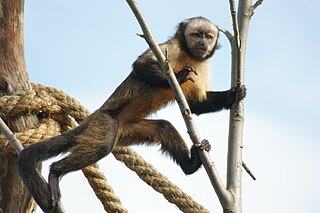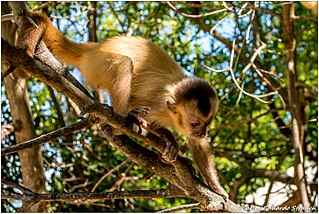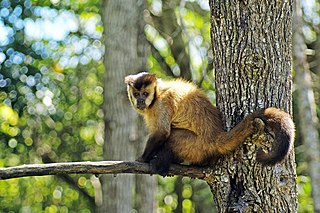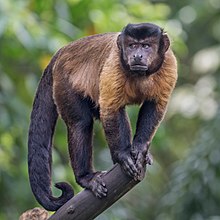
The Cebidae are one of the five families of New World monkeys now recognised. Extant members are the capuchin and squirrel monkeys. These species are found throughout tropical and subtropical South and Central America.

The Panamanian white-faced capuchin, also known as the Panamanian white-headed capuchin or Central American white-faced capuchin, is a medium-sized New World monkey of the family Cebidae, subfamily Cebinae. Native to the forests of Central America, the white-faced capuchin is important to rainforest ecology for its role in dispersing seeds and pollen.

The golden-bellied capuchin, also known as the yellow-breasted or buff-headed capuchin, is a species of New World or neotropical monkey. It lives mainly in trees and are omnivorous, eating a wide variety of both plant and animals as food. Golden-bellied capuchin normal home range is in the Atlantic forest of Brazil and it is critically endangered due to forest fragmentation and habitat loss mainly due to agriculture, there are currently efforts to protect them by the local government.

The capuchin monkeys are New World monkeys of the subfamily Cebinae. They are readily identified as the "organ grinder" monkey, and have been used in many movies and television shows. The range of capuchin monkeys includes some tropical forests in Central America and South America as far south as northern Argentina. In Central America, where they are called white-faced monkeys ("carablanca"), they usually occupy the wet lowland forests on the Caribbean coast of Costa Rica and Panama and deciduous dry forest on the Pacific coast.

White-fronted capuchin can refer to any of a number of species of gracile capuchin monkey which used to be considered as the single species Cebus albifrons. White-fronted capuchins are found in seven different countries in South America: Bolivia, Brazil, Colombia, Venezuela, Ecuador, Peru, and Trinidad and Tobago.

The Kaapori capuchin, also known as the Ka'apor capuchin, is a species of frugivorous, gracile capuchin endemic to the Brazilian Amazon. Their geographical home range is relatively small and is within the most densely populated region of the Amazon. With the strong human presence nearby,C. kaapori has had to deal with very large amounts of disturbances to their habitat and is one of the most endangered of the neotropical primates.

The wedge-capped capuchin or Guianan weeper capuchin is a capuchin monkey from South America. It is found in northern Brazil, Guyana and Venezuela. Cebus olivaceus is known to dwell in tall, primary forest and travel over long distances during the day.

The black capuchin, also known as the black-horned capuchin, is a capuchin monkey from the Atlantic Forest in south-eastern Brazil and far north-eastern Argentina. Historically, it was included as a subspecies of the tufted capuchin.

The black-striped capuchin, also known as the bearded capuchin, is a New World monkey in the family Cebidae. They can be found in northern and central Brazil. These capuchins mostly live in dry forests, and savannah landscapes between the Rio Araguaia and the Rio Grande. Known for its tool use, the black-stiped capuchin has been shown to use tools in a wide variety of situations, ranging from using rocks for nut cracking to using sticks for digging. They were, until recently, considered a subspecies of the tufted capuchin, but because of more research and insights, they are considered their own species by many.

The large-headed capuchin is a subspecies of the tufted capuchin monkey from South America. It is found in Bolivia, Brazil, Colombia, Ecuador and Peru. It was formerly thought to be its own species, but studies have found it to be a subspecies of the tufted capuchin.

The blond capuchin is a species of capuchin monkey endemic to northeastern Brazil. This endangered species was rediscovered in 2006. It can live in exceptionally large groups of over 150 individuals, and like other capuchin species, exhibits a complex and high level of sociality. It is threatened by loss of habitat due to agriculture, primarily sugarcane fields. In many cases this has caused sugarcane to make up a large portion of their diet, which would otherwise consist of mostly fruit and small animals. The blond capuchin is known to inhabit both the Atlantic forest and Caatinga biomes, although the habitation of the Caatinga may be a recent choice caused by human encroachment into its former habitats. Like other primate species, the blond capuchin is also threatened by poaching and capture for the illegal pet trade.

Tool use by non-humans is a phenomenon in which a non-human animal uses any kind of tool in order to achieve a goal such as acquiring food and water, grooming, combat, defence, communication, recreation or construction. Originally thought to be a skill possessed only by humans, some tool use requires a sophisticated level of cognition. There is considerable discussion about the definition of what constitutes a tool and therefore which behaviours can be considered true examples of tool use. A wide range of animals, including mammals, birds, fish, cephalopods, and insects, are considered to use tools.

Primate cognition is the study of the intellectual and behavioral skills of non-human primates, particularly in the fields of psychology, behavioral biology, primatology, and anthropology.

Robust capuchin monkeys are capuchin monkeys in the genus Sapajus. Formerly, all capuchin monkeys were placed in the genus Cebus. Sapajus was erected in 2012 by Jessica Lynch Alfaro et al. to differentiate the robust (tufted) capuchin monkeys from the gracile capuchin monkeys, which remain in Cebus.

Gracile capuchin monkeys are capuchin monkeys in the genus Cebus. At one time all capuchin monkeys were included within the genus Cebus. In 2011, Jessica Lynch Alfaro et al. proposed splitting the genus between the robust capuchin monkeys, such as the tufted capuchin, and the gracile capuchins. The gracile capuchins retain the genus name Cebus, while the robust species have been transferred to Sapajus.

The crested capuchin or robust tufted capuchin is a species of robust capuchin monkey. It is endemic to Brazil. It was formerly considered a subspecies of the black capuchin but is now considered by some to be a separate species.

Azaras's capuchin or hooded capuchin is a species of robust capuchin. It occurs in eastern Paraguay, southeastern Bolivia, northern Argentina, and Brazil, at Mato Grosso do Sul and Mato Grosso states, in Pantanal. Its habitat consists of subtropical, humid, semi-deciduous, gallery forests and forested regions of the Pantanals. Formerly, it was considered a subspecies of black-striped capuchin, according to Groves (2005) with the name Cebus libidinosus paraguayanus, but Silva Jr. (2001) considered it a separated species. They are considered as frugivores-insectivores which means that their diet mainly consists of a variety of fruits, seeds, arthropods, frogs, small mammals, etc.
Social learning refers to learning that is facilitated by observation of, or interaction with, another animal or its products. Social learning has been observed in a variety of animal taxa, such as insects, fish, birds, reptiles, amphibians and mammals.
Primate archaeology is a field of research established in 2008 that combines research interests and foci from primatology and archaeology. The main aim of primate archaeology is to study behavior of extant and extinct primates and the associated material records. The discipline attempts to move beyond archaeology's anthropocentric perspective by placing the focus on both past and present primate tool use.

The Margarita Island capuchin, also known as the tufted Margarita Island capuchin or mono de margarita is a subspecies of the tufted capuchin that only resides in the Caribbean Sea on Margarita Island, Venezuela.





















